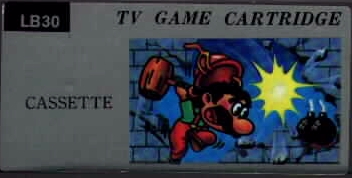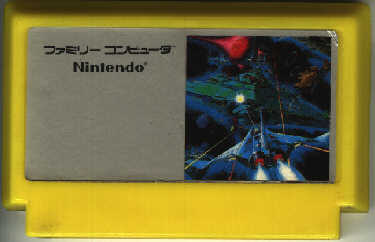 Here's an example "TV Game Cartridge Cassette". This one's actually Wrecking Crew.It's really impossible to tell how much pirate software was released for the Famicom and NES. There's just so much of it! It's to the point where it's actually easier to find pirate stuff in the US than it is to find real, licensed Famicom carts. Piracy really started in full blast around 1988 and steadily rose thereafter, despite the efforts of Nintendo. In places like China, Taiwan and southeast Asia, any effort to stop cart piracy like this is pretty much worthless since it's so rampant. One can go into nearly any department store in Hong Kong and buy CD's filled with SNES games for $10. At one point in 1991, Nintendo exposed a pirate company in Taiwan that the Taiwanese government itself had a 30 percent stake in. In other countries where NESes weren't actually sold, everything was 100 percent pirated. In these places, companies with names like SuperVision, Chui, and Cony became kings of the piracy hill, churning out multicarts like mad and actually becoming big enough to put their own name on the carts. When companies like SuperVision tried making NES carts for the US market, they ran into some trouble, since Nintendo of America was ready and willing to battle them. Battle they did, with export confiscations and injunctions and even putting anti-piracy propaganda in the back of Nintendo Power, but many pirate NES carts still made it through nonetheless. Many Asian black-market companies are still in business, and a wholly new development in NES collecting has resulted - Asian original productions. Beginning with Master Fighter in mid-1992, companies in Taiwan began making their own games, usually making unauthorized ports of popular fighting games like Street Fighter II or Fatal Fury. Some are as bad as you'd expect, but some Asian originals, such as Kart Fighter and the Sonic port Somari are excellently coded and rank up there with "legal" NES games. As for collecting pirates.. initially it's exciting but after awhile it can get boring for anyone but the hard-core collector. All multicarts tend to have pretty much the same set of games, and most beef up their game count by offering the same game again and again in a million different variations. After awhile, you really wish you could find more -real- Famicom games, and that's the really hard thing if you don't live in Asia. How can you tell if a cart is a pirate version? Generally speaking, it's a pirate if:

Back to the odd page. |
 Still, the most interesting thing about these carts almost always
is the silly label art on the cart itself. Take this one, for example. As you'll see in the odd section of this
web page, pirate carts have all sorts of funny labels, but this one has to be the silliest label I've ever
seen. (Thanks to photon for this.) The picture is the same as the one on NES Gradius.. but where did the text go?! Did the
printers forget to put anything there? Part of the allure of collecting pirate stuff is the rather
strange things pirate companies do to somehow assure people that the cart is legit when it
obviously isn't. As a result, all this company did was put "Family Computer", then "Nintendo"
then thought that was good enough. Who knows what they were thinking.
Still, the most interesting thing about these carts almost always
is the silly label art on the cart itself. Take this one, for example. As you'll see in the odd section of this
web page, pirate carts have all sorts of funny labels, but this one has to be the silliest label I've ever
seen. (Thanks to photon for this.) The picture is the same as the one on NES Gradius.. but where did the text go?! Did the
printers forget to put anything there? Part of the allure of collecting pirate stuff is the rather
strange things pirate companies do to somehow assure people that the cart is legit when it
obviously isn't. As a result, all this company did was put "Family Computer", then "Nintendo"
then thought that was good enough. Who knows what they were thinking.